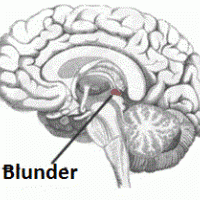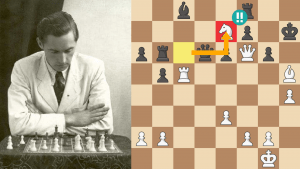
Return of the Blunder Gland, Part One
Quite a while ago I was asked to teach a Southern California chess camp filled with very young children. On the first day, I lectured about some really basic things, only to discover that virtually all the kids would hang everything as quickly as possible. This stark reality forced me to throw out all my preparation, and instead I had to show them how to hold on to their stuff. At first I addressed their “hanging everything disease” calmly, but they continued to give away anything that wasn’t nailed to the board. Then I added an edge to my voice, but they still hung everything. And finally I begged, but they just laughed at me and hung even more stuff!
Going back to the drawing board, I devised a bit of a game: I’d pair them off against each other, and they would play a 10-move game (not a move more!). The goal: don’t hang anything for 10 moves. I didn’t care if they developed, or controlled the center, or did anything useful at all – all they had to do was concentrate hard on not giving away their pieces for 10 whole moves.
The result: each player hung massive amounts of material in each game. Here’s one example that I still remember to this day: 1.d4 Nc6 2.Bg5 e6 (Hanging the Queen on move 2!!!)
3.a4 Qxg5. Good grief!
At least the event ended on an “interesting” note: one 6-year-old was so tired of me saying, “Make sure your pieces are safe!” that he confidently crossed the room and kicked me in the gonads with all his might. After I dragged myself off the floor, I jumped in my car and escaped the scene. However, it did make me think about that huge, oh-so-important leap from “I can’t stop giving my stuff away” to “Let’s control the center with pawns!”
The fact is, basic tactics and positional basics will prove useless if you can’t hang onto your chessmen. And this great truth hit me in the face (again) when some chess.com members shared their games where pieces were flying off the board faster than a Raptor Drone flies after its prey. Here's a good example:
Timothy (a beginner) vs. Chess Engine
1.d4 Nf6 2.c4 d5
A very common amateur mistake (the engine was clearly on mercy mode, which usually entails bad openings and purposely played blunders so that the opponent has a chance)! The problem with this move is that it allows White to trade a side pawn (c4) for black’s central pawn (d5) without Black being able to bring a new pawn to d5, which would give him a central presence. Compare this with 1.d4 d5 2.c4 e6 (or 2…c6). Now if White takes on d5, Black retains central control by 2…exd5 or 2…cxd5.
Though many games see White responding (after 2.c4 d5) with 3.Nf3 or 3.Nc3, this allows Black to return to main line openings via 3…c6 or 3…e6. Thus, white’s most testing response is 3.cxd5! Nxd5 4.e4 (Thanks for the center! Also strong is 4.Nf3, intending to play e2-e4 a bit later) 4…Nf6 5.Nc3 e5 (Trying to show that white’s center is overextended, but this just isn’t the case. Quiet lines like 5…e6 give White a free ride.) 6.Nf3 exd4 (6…Bg4 7.dxe5 Qxd1+ 8.Kxd1 Nfd7 9.Nd5 Kd8 10.Bg5+ Kc8 11.Rc1 Nc6 12.Bf4 is very good for White) 7.Qxd4 Qxd4 8.Nxd4 and the Queenless middlegame is very pleasant for White. Here are two classic examples:
8…Bb4 9.f3 c6 10.Bg5 Nbd7 11.0-0-0 h6 12.Bh4 0-0 13.Nf5 g6 14.Nd6 (and not 14.Nxh6+ Kg7 15.Ng4 Nxg4 16.fxg4 Nf6 17.Bxf6+ Kxf6 with excellent compensation for the pawn) 14…Kg7 15.Bc4 b5 16.Bb3 (16.Be2!?) 16…Nc5 17.e5 (17.Bc2!?) 17…Nxb3+ 18.axb3 Ng8 19.Nxc8 (19.Nce4!?) 19…Raxc8 20.f4 (20.Rd7!?) 20…Rc7 21.Ne4 c5 22.Rd5 c4 23.Kc2 a6 24.Rhd1 Be7 25.Bxe7 cxb3+ 26.Kxb3 Rxe7 27.Rd7 Rfe8 28.Kb4 f6 29.e6 f5 30.Nc5 Ra8 31.R1d6 a5+ 32.Kxb5 Kf6 33.Rd8 Rxd8 34.Rxd8 Kg7 35.Kc6 Nf6 36.Kd6 Re8 37.Rxe8 Nxe8+ 38.Ke7 Nf6 39.Kd8, 1-0, A.Kotov – V.Ragozin, [D06] Leningrad 1956.
8…Bc5 9.Ndb5 Na6 10.Bf4 Bb6 11.Be2 0-0 12.0-0 Bg4 13.Bxg4 Nxg4 14.Nd5 c6 15.Nxb6 axb6 16.Nd6 Nc5 17.f3 Nf6 18.Rfd1 Rfd8 19.Be3 Kf8 20.b4 Na4 21.Nxb7 Rxd1+ 22.Rxd1 Ke7 23.Nd6 Nc3 24.Nf5+ Kf8 (Alekhine’s opponent has completely outplayed him, and after a move like 25.Rd6 the soon-to-be World Champion would have been toast. However, something unfortunate happens.) 25.Rc1?? Ne2+ (DOH!), 0-1, O.Zimmermann – A.Alekhine, Basel Simultaneous 1925.
3.Nf3 e6
Now we’ve transposed into a Queen’s Gambit Declined.
4.g3
And now it’s a Catalan!
4…Nc6
Usually it’s not wise to block your c-pawn (as either color) in d-pawn openings. However, some strong players (like Taimanov, Benjamin, Bisguier, Palliser, and even Nakamura, just to name a few) have made use of this Knight move, so both players are still playing “like a grandmaster!”
5.Bh3?
And here the illusion crashes. The Bishop is very badly placed here (it’s hitting a rock on e6). 5.Bg2, taking aim at d5 and hoping to rule the h1-a8 diagonal if Black ever captures with …dxc4, is correct.
5…dxc4 6.Nc3
Okay, are you ready? GENTLEMEN, START YOUR BLUNDER ENGINES!
6…Nxd4??
Say WHAT? If you feel that your opponent has given you something for free, it’s important to make sure it’s really a gift and not some kind of trap! Thus, don’t just snap something off without making sure you won’t be gutted by some unforeseen danger! Of course, in this case the computer’s programming was to blame.
7.Nxd4
“Oh, for me? You really shouldn’t have – but if you insist!”
7…e5!
Things are getting a bit complicated, so it’s important for both players to sit back and assess the position to the best of their abilities. However, the FIRST thing you should do is to look at all your developed pieces and make sure they are safe. For White, that’s only 3 pieces: both Knights and the h3-Bishop. If you do that, you’ll most likely notice that the d4-Knight is being hit by black’s e5-pawn, and the h3-Bishop is being attacked by black’s c8-Bishop. Let me repeat: make SURE all your developed pieces are safe. This doesn’t mean a quick glance, this means you look at all your opponent’s pieces and pawns and see if they are taking aim at your stuff.
8.Be3???
SAY WHAT??? This move announces confusion. But confused or not, you can’t allow your opponent’s pawn to eat your minor pieces! As for the h3-Bishop, White clearly missed the sudden (and sneaky!) attack by the c8-Bishop completely.
White would have had a winning position after either 8.Bxc8 and 8.Qa4+, in both cases with a material advantage of a piece for two pawns.
8…Bxh3
Suddenly Black is winning!
9.Qa4+??
Simply 9.Nf3 saves the piece, though Black will (by some miracle) end up with two extra pawns.
9…Bd7
If you intend to check someone (as White did on move 9), make sure you look at all the ways your opponent can get out of check. Once you notice 9…Bd7 (and if you look for ALL the ways Black can get out of check, you’ll eventually see it), you’ll realize that Qa4+ isn’t the way to go.
10.Qc2??
10.Ndb5 a6 still picks up a piece, thanks to the pin along the a4-e8 diagonal. Best was 10.Qxc4 exd4 11.Bxd4, though Black would then be a whole piece ahead with a dead won position.
10…exd4 11.Bxd4 Bc6
Creating a double attack against the Bishop on d4 (by black’s Queen) and the Rook on h1 (by the c6-Bishop).
12.O-O-O?
White could have avoided further material loss by 12.Bxf6 Qxf6 13.0-0, though he would still be so far down that the result should be a foregone conclusion.
12…Bxh1 13.Bxf6 Bc6??
Arrrgghh! Black’s Queen is hanging to two different white pieces! Black, of course, noticed this, but (being a benevolent machine) wanted to give White a chance. Black should have played 13…Qxf6 14.Rxh1 when white’s “merely” a Rook and pawn behind.
14.Bxd8 and White went on to win the game.
Timothy, don’t despair. When ANYONE starts out, they hang stuff. It’s a normal part of the learning experience. Unfortunately, it’s such a massive problem that you can’t move ahead until you fix it. Yes, everyone hangs material from time to time – I don’t expect you or anyone on chess.com to never hang the occasional pawn or piece. But you need to make that kind of blunder the exception, not the rule.
One way to work through this is to play a series of 10 move games vs. your computer. Your goal: to not hang anything. Thus you will concentrate over those 10 moves very hard, making sure your pieces are safe, protected, and secure. Of course, this doesn’t mean you can’t trade stuff, but giving away pieces for nothing? No, not allowed. If you can’t do this on your own, have your teenage son/daughter or wife zap you with a cattle prod every time you hang something (trust me, they will enjoy it … you, not so much). You’ll be "shocked" at how quickly you stop giving pieces away!
Send me another game in a few months and we’ll see how you’re doing!
Some basic advice for the chronic blunderer:
* If you feel that your opponent has given you something for free, it’s important to make sure it’s really a gift and not some kind of trap! Thus, don’t just snap something off without making sure you won’t be gutted by some unforeseen danger!
* The FIRST thing you should do is to look at all your developed pieces (they are closer to the enemy army and thus more vulnerable), and also at any of your pieces that are standing on an opening file face to face with an enemy Queen or Rook, and make sure they are safe. This doesn’t mean a quick glance, this means you look at all your opponent’s pieces and pawns and see if they are taking aim at your stuff.
* If you intend to check someone, make sure you look at all the ways your opponent can get out of check. If you see that he can get out of check in a manner that actually hurts you, then why check him in the first place?
We’ll occasionally do “Blunder Gland” games since quite a few players on this site are beginners, and they deserve just as much consideration as everyone else. Everyone, of any rating, has a chance of being heard in this column.






